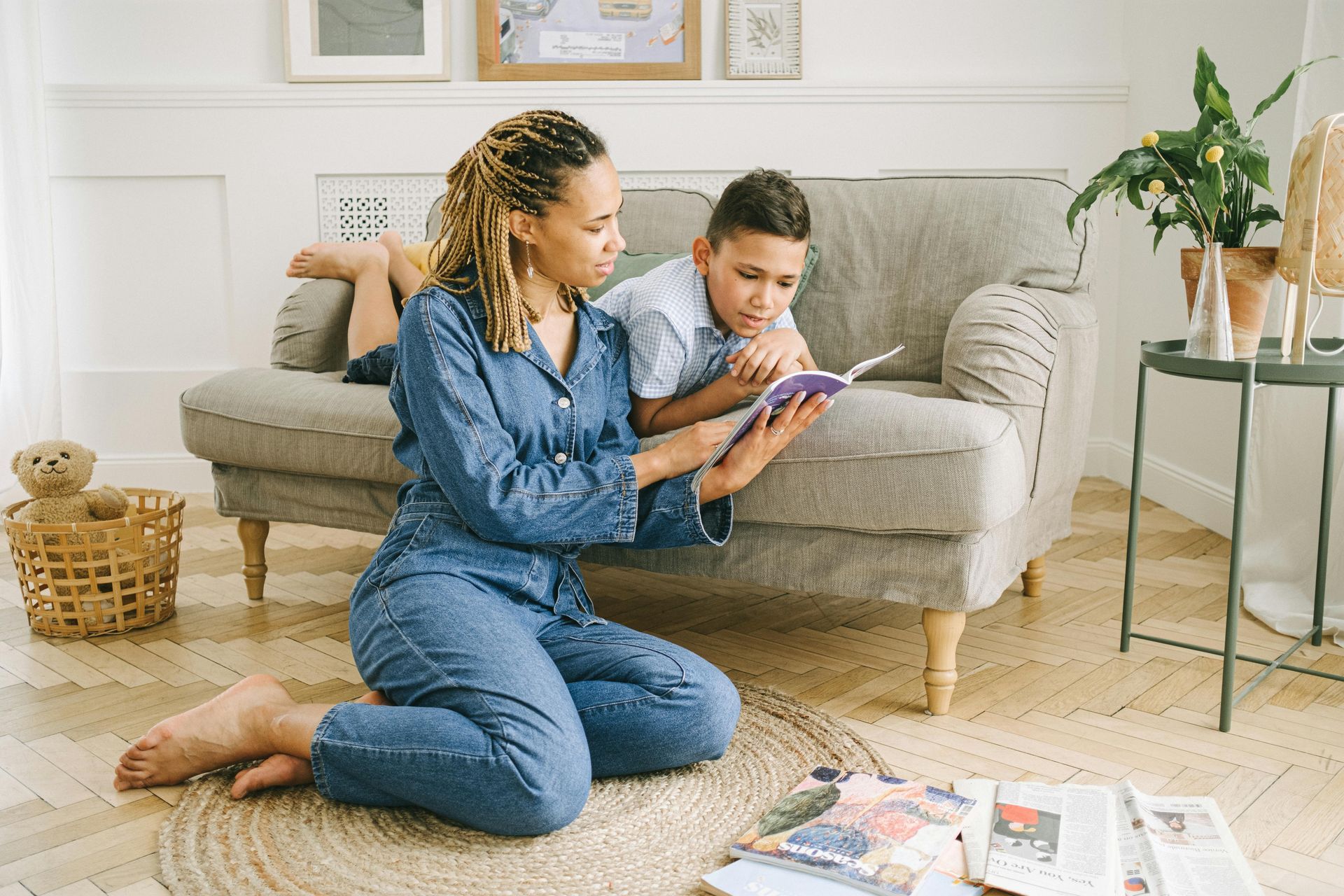Blog
Comprehension Strategies That Work at Home
Anne Hauth • December 12, 2025
Comprehension is the ultimate goal of reading. Without it, a striving reader is just word calling. Strong comprehension allows kids to think critically as they read, enjoy stories on a deeper level, and apply what they learn from texts to real life.
Your kids are likely working on comprehension at school, but it's important--and easy!--to reinforce these skills at home. Research shows that interactive reading with adults has myriad benefits to kids, including deepening comprehension (National Reading Panel, 2000). Here are four easy strategies to try next time you read with your kids.
1. Ask Questions
Ask your child questions before, during, and after reading. This encourages them to consistently think about meaning from start to finish. If they know they need to answer questions about a story, they'll put more effort into understanding it. Ask your child questions such as:
- Before reading: "What do you think this story will be about?
- During reading: "Why do you think the character made that choice?" or "What do you think will happen next?"
- After reading: "What lesson did the character learn?" or "What was the most exciting part of the story?"
2. Retell Stories
After reading together, ask your child to retell the story in their own words. This is one of the most effective ways to strengthen comprehension, as it helps kids recall details, put events in a sequence, and understand the main idea. Try the following ideas:
- Ask your child to tell you what happened at the beginning, middle, and end of the story.
- Ask your child to pretend they're making a movie trailer for the story: How would they describe it?
- Ask your child to act out the story as a play or puppet show.
3. Connect to Real Life
Kids are more able to understand and remember stories if they can connect them to their own lives. Making these connections personalizes their reading experience and makes the text more interesting and engaging. Ask your child questions such as:
- "Have you ever felt like this character?"
- "Do you know anyone who has had a similar experience?"
- "How would you have handled the problem in this story?"
- "Did the setting remind you of anyplace you've been?"
4. Have a Book "Show and Tell"
If your child wants to read a book with you that they've already read on their own, first ask them to do a "show and tell" about the book. Have them present it to you with prompts such as:
- This book is about...
- I think it's interesting because...
- I want to read it with you because...
- One thing it taught me was...
- One thing I think you'll like about it is...
- My favorite thing about it is...
You could incorporate weekly or monthly show and tells into your reading routine and make it a fun family activity.
Each of these strategies allows your child to build comprehension by reflecting on meaning and engaging in critical thinking. By making reading together an interactive activity, you're helping your child become a more curious and thoughtful learner.
If your child needs extra support in reading comprehension, check out One Minute Reader. As kids work through each high-interest, nonfiction story in this program, they build fluency and vocabulary--both of which are highly correlated with comprehension. They also focus directly on strengthening comprehension by answering questions at the end of each story. These questions are tied to specific comprehension-building strategies: finding the main idea, recalling key details, understanding vocabulary words in context, making inferences, and writing short-answer responses.
National Reading Panel. (2000). Teaching children to read: An evidence-based assessment of the scientific research literature on reading and its implications for reading instruction.
National Institute of Child Health and Human Development.
Highlighted Posts

The other day, my son asked me why blizzards are hazardous. The most interesting part of his question was the way he said the word hazardous. He pronounced it incorrectly, with a long a: HAYzardous. This told me he’d never heard the word spoken aloud before. However, when I probed him on the word’s meaning, he knew it exactly. How? He came across the word in a book he was reading. He didn’t know what it meant, but he figured out the meaning using context clues. Sometimes an unknown word can stop a reader in their tracks, shutting down comprehension. But if the reader has the ability to figure the word out, comprehension can continue, and the new word becomes part of the reader’s vocabulary. According to the research, vocabulary and comprehension are strongly linked. Students with low vocabulary scores tend to have low comprehension, and vice versa. Students acquire vocabulary incidentally through exposure to words at home and at school—by listening and talking, by reading books with adults, and by reading widely on their own. Students, especially struggling readers, also benefit greatly if they are taught strategies for vocabulary acquisition. Vocabulary activities should aim to engage students in actively thinking about word meanings, the relationships among words, and how we can use words in different situations. Effective strategies for vocabulary practice include: Student-Friendly Definitions : The meaning of a new word should be explained to students at their level, rather than just providing a dictionary definition. Defining Words Within Context : The most effective time to introduce an unknown word’s meaning is often at the moment the reader meets the word in the text. Using Context Clues : Students should learn to infer the meaning of a word by looking closely at surrounding text. Sketching Words : For many students, it is easier to remember a word’s meaning by making a quick sketch that connects the word to something personally meaningful to the student. Applying Words : When students are challenged to apply new words to their own experiences, they have another opportunity to deeply process its meaning. Analyzing Word Parts : If students know the meanings of root words and affixes, they are more likely to understand a word containing these word parts. Semantic Mapping : Semantic maps help students develop connections among words—for example, by writing an example, a non-example, a synonym, and an antonym. Developing Word Consciousness : Students who are word conscious are aware of and interested in the words around them. Teachers can promote word consciousness by helping students use: Language categories: Students learn to make finer distinctions in their word choices if they understand the relationships among words, such as synonyms, antonyms, and homographs. Figurative language: The ability to use figures of speech is also a part of word-consciousness. The most common figures of speech are similes, metaphors, and idioms. We’ve strongly incorporated vocabulary development into One Minute Reader . If your child is using One Minute Reader, there are many ways for them to build vocabulary and increase comprehension: During the Cold Read step, they should click on unknown words to hear the words pronounced immediately. During the Read Alone step, they should click on highlighted vocabulary words to see and hear the definitions. They can also use our free Difficult Word List resource to sketch and record words they struggled with so that they may review them later. For targeted, game-based vocabulary practice, check out the Splat-O-Nym iPad app . With audio support and immediate feedback, Splat-O-Nym helps students learn pronunciation and enhance their vocabulary acquisition through fun activities. The app includes over 7,000 synonym questions, 1,000 antonym questions, and 600 meaning-from-context questions. After I answered my son’s question about blizzards, I high-fived him for figuring “HAYzardous” out as he read. At One Minute Reader, we're here to help you mitigate the hazards of low vocabulary and ensure your child has the tools they need to become a successful reader.

Regardless of where kids are on their reading journey, there are countless ways to incorporate reading into cozy days at home this winter. Here are some easy ideas for kids to try at home over winter break and beyond! Have kids think of the trusted friends, family members, or adults in their lives who can read, and encourage them to read aloud with these people as often as possible. Depending on their reading ability, they can simply listen to a book read aloud, or they can take turns reading and being read to. Have the kids fill out this Read-Aloud Log every time someone reads to them or every time they read to someone. You could offer a small reward for completing this activity every day of winter break (or every day during a predetermined time period). Reading aloud to their pets, stuffed animals, or even to themselves counts too! Set up reading challenges in which kids set goals and record their minutes spent reading or the number of books they read. Have kids color and decorate these winter-themed bookmarks to make reading even more fun. Encourage kids to borrow books from the library and have a big pile to choose from on cozy winter days. See this Cozy Wintertime Book List for book ideas. Refer to our 7 Ways to Create a Cozy Reading Environment document to create an ideal reading space. Lend or gift kids the first book in a series that’s likely to hook them. Sometimes all it takes is the right series to turn a reluctant reader into a bookworm! Incorporate reading time into other fun activities. For example, while making dinner or baking holiday treats, kids can read the recipes and write out the grocery lists. Create a snowflake book wall. Print out this Snowflake Wall Template , and have kids fill out a snowflake each time they finish a book. Then, have them tape the snowflake to the wall. Encourage kids to find ways to read while playing favorite games or while spending time on electronic devices. While playing games, have them read the game instructions aloud. While watching shows, have them turn on and read the subtitles. Have kids practice reading and writing while completing this fun Winter Scavenger Hunt . They’ll get some fresh air too! Refer to this Send Some Cheer printable for addresses to places where kids can send letters. Have them practice their writing skills and spread kindness by writing to kids in hospitals, senior citizens, refugee children, and more. Set up daily One Minute Reader time, and see literacy progress in just minutes! This research-proven, parent-trusted program is free for 7 days and just $8/month after that. Your kids will have so much fun beating their goals, they won't want to stop. Download the Splat-o-Nym vocabulary iPad app , which keeps kids entertained while boosting their vocabulary. Kids can try a free version of this game and purchase to get the full experience. Note that this app is only available for iPads, not smartphones or other devices. Add your own ideas to this list! Our hope is for all kids to experience the joy of reading this winter season and always.
Ready to see an improvement in your child's reading?
Sign up today and get seven days for FREE.
One Minute Reader is just $8 per month after your free trial.

